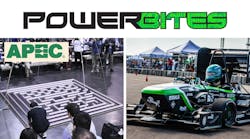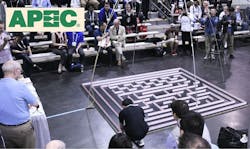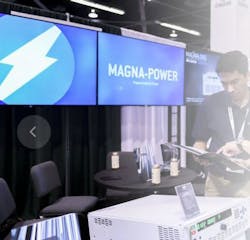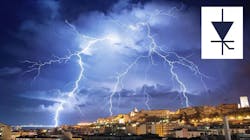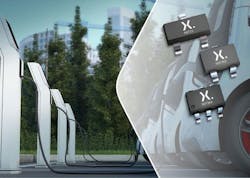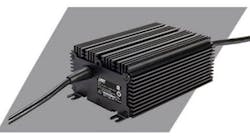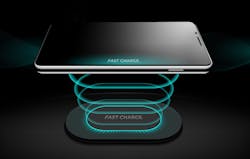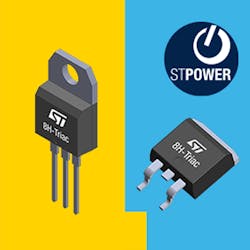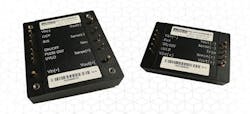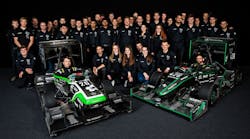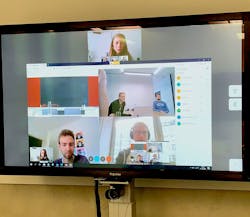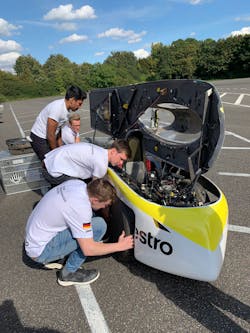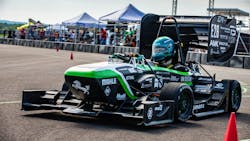This Week in PowerBites: APEC to Go Live, Virtual E-Racing Seminars
>> Electronic Design Resources
.. >> Library: Article Series
.. .. >> Article Series: PowerBites
APEC Returns from Cyberspace – June 9-12 in Phoenix, Ariz.
After spending a year in cyberspace as a virtual event, the Applied Power Electronics Conference (APEC) will be holding its annual gathering as a live, in-person event, June 9-12, 2021 in Phoenix, Ariz. The chance to once again meet face-to-face with our colleagues to learn, share knowledge, and savor the contents of hotel mini-bars may perhaps mark the start of a new, more hopeful time for our industry and, hopefully, the world.
The APEC committee is moving forward with the clear understanding that although the June dates should be past the time that the worst of the pandemic is behind us, they’re prepared to update plans if necessary. For now, however, event registration will open on February 25, with housing registration going live around the same time. The conference program hasn’t been posted yet, but the organizers are promising it will offer the usual wide range of professional education seminars, technical sessions, industry sessions, and other activities, as well as a large, lively exhibit hall.
To learn more, visit http://apec-conf.org/
Rethinking Surge Protection
Is it time to rethink how we protect electrical circuits in home appliances, industrial systems, and motorbike voltage regulators? STMicroelectronics' recent blog shows why it's time to reevaluate your inrush current protection strategies to meet the growing demand for industrial and consumer products that can survive harsher conditions. Although the blog is based on ST's recently introduced TN family of high-temperature thyristors (up to 150°C), it provides lots of practical information about general design practices for achieving higher levels of surge protection.
To read the blog, click here.
First 80-V RETs for 48-V Automotive and Other Higher-Voltage Bus Circuits
Nexperia has introduced what it says is the industry’s first 80-V RET (resistor-equipped transistor) family. These new RETs, aka “digital transistors,” provide enough headroom for use in 48-V automotive board net (e.g., mild hybrid and EV cars) and other higher-voltage circuits that are often subject to large spikes and pulses that previous 50-V parts can’t handle.
Why RETs?
RETs save space and reduce manufacturing costs by combining the bias resistor and bias-emitter resistor in the same SOT23 (250 mW Ptot) or SOT323 (235 mW Ptot) package as the transistor. Double RETs (two transistors and two matching bias resistors and bias-emitter resistors) are also available in the SOT363 package, sporting a Ptot of 350 mW for even greater integration and savings.
The new series (NHDTx and NHUMx) includes 42 parts with PNP/NPN combinations. These come with the same bias resistor combinations as Nexperia’s 50-V parts. Devices have a 100-mA current capability and are AEC-Q101-approved.
More information including product specs and datasheets is available at www.nexperia.com/RETs
When the Going Gets Tough, the Supplies Get Tougher
Calex Manufacturing introduced its LHC Series of 250-W ac-dc power supplies, created specifically for use in harsh environments, such as outdoor signs, automated assembly lines, and manufacturing applications. The series features a ruggedized, fully potted, and sealed weatherproof enclosure and efficient thermal design. The supply’s thermal efficiency enables it to operate reliably with pronged exposure to severe weather conditions and harsh shock and vibration.
The LHC series of fixed, single-output voltage supplies is available with outputs of 12, 24, and 48 V dc along with constant-current overload protection. They also include a universal ac input with an active PFC, enabling the supply to reach a peak efficiency of 95%. The supply electronics are housed in an air-cooled ruggedized Ingress Protection 67 (IP67) rated enclosure that can operate in an ambient temperature range of −20 to +50°C. All LHC series power supplies measure 6.29 x 3.90 x 2.24 inches, with a weight of 3.46 pounds, and come with an EMI filter that meets Class B CISPR and FCC standards. The supplies are RoHS-compliant and IEC 60950-1-certified.
For more product specifications, the datasheet is available for download on www.calex.com. For samples and pricing, call 508-212-5306.
Ruggedized 700/800-V Superjunction MOSFETs Target TV, LED Lighting, and Fast Charger Apps
MagnaChip Semiconductor recently unveiled eight new 700- and 800-V series high-voltage superjunction (SJ) MOSFETs that are specifically optimized for TV, LED lighting, fast chargers, and other industrial applications with high or unstable input voltages. They feature an embedded Zener diode between gate and source to avoid damage from an external surge or electrostatic discharge, enhancing robustness and reliability. The devices also offer improved power efficiency and reduced switching losses, thanks to a total gate charge that's 30% lower than the company’s previous generation of SJ MOSFETs.
For additional information, visit www.magnachip.com.
High-Temperature Snubberless Triacs Save Space and Boost Reliability
STMicroelectronics’ 800-V 8H triacs operate at full rated current up to the maximum junction temperature of 150°C. As a result, heatsinks in drives for ac loads can be up to 50% smaller to combine compact dimensions with high reliability. Suited to industrial, personal care, smart-home, and smart-building applications, the new triacs leverage ST’s latest Snubberless high-temperature technology to achieve their ruggedness. With low on-state voltage (VTM), which ensures high operating efficiency and minimizes self-heating, the devices also have low-leakage current that’s stable over time to reduce standby losses. In addition, robust dynamic performance with high critical turn-off current slope prevents unwanted commutation.
Capable of safely driving inductive loads, the 8H triacs let designers create rugged and efficient controls for HVAC systems, ac-motor drives, water heaters, room heaters, lighting systems, home appliances, and smart ac plugs. The complete 8H family spans current ratings from 8 to 30 A.
Peak off-state voltage of 800 V ensures robust performance in ac-line-powered applications including three-phase equipment operating from up to 400 V rms. The devices benefit from high noise immunity and can withstand fast voltage transients up to 6 kV and voltage gradient (dV/dt) up to 2000 V/µs across the full junction-temperature range.
ST’s 8H triacs are in production now, in D2PAK, TO-220AB, and TO-220AB insulated packages, priced from $0.39 for orders of 1000 pieces. Further pricing options are available for larger quantities.
For additional information, visit www.st.com/800v-8h-triacs
Railway-Grade 10:1 Ratio DC-DC Converters Available in Half- and Quarter-Brick Packages
Two new ultra-wide 10:1 ratio dc-dc converters—the 250W IRH-W80 half-brick and the 150W IRQ-W80 quarter-brick—were recently announced by Murata Power Solutions. Offering efficiency levels above 91% with a 16- to 160-V dc input voltage range, the modules comply with the requirements of EN50155 for shock, vibration, extreme temperatures, and humidity necessary for embedded applications in the railway and industrial sectors.
Typical applications include powering equipment on trains, such as infotainment, communications, and lighting, and from a wide range of battery voltages that require a reliable dc source. The modules also can be used in other industrial applications that operate from batteries in harsh environments.
The 250W IRH-W80 and 150W IRQ-W80 have a baseplate operating ambient temperature range of −40 to 100°C. Single 12-, 24-, and 54-V output models are available with galvanic isolation between the input and output in excess of 4 kV dc. Additional features include remote enable on/off (selectable positive or negative), a ±10% output voltage adjustment range, remote sense, hold up function, pulse out feature, and adjustable overcurrent protection.
The adjustable undervoltage-lockout protection feature protects the power bricks' supply batteries against damage due to deep discharge. Both modules also feature self-protection against external short circuits and overtemperature protection with self-resetting ability.
Evaluation boards for the 250-W IRH-W80 and 150W IRQ-W80 are available upon request. For more information about the series, visit here or here, respectively.
Student E-Racers Use Virtual Tech Seminars to Prepare for Post-Pandemic Competition
When the global pandemic threatened to shut down its student e-racing program, Würth Elektronik kept the aspiring racers moving ahead with a two-day program of intensive virtual seminars for each of their sponsored student electric-vehicle racing teams. Each of these teams competes in the electric-vehicle division of the "Formula Student" international engineering design competition, created by the Society of Automotive Engineers in 1979. The content of each seminar was specially adapted to the needs and requests of the respective teams: Greenteam Uni Stuttgart e.V., KA RaceIng e.V., HHN Racing e.V., and Team Sonnenwagen Aachen e.V.
Virtual Innovation
To help the teams stay active during the pandemic, they reinvented the first intensive seminar, initially planned as a face-to-face event for the end of October 2020, as a virtual event. In total, 12 developers received exclusive training on surge, burst, and ESD protection; EMC with design tips and filter circuits; SMD ferrites; EMC and efficiency optimization of high-power dc-dc converters; common-mode chokes; and industrial radio standards.
During that time, staff from Würth's Research & Innovation Center met with the Sonnenwagen Aachen team's developers via video conference. Sonnenwagen Aachen has already developed two solar-powered vehicles and participates annually in international competitions such as the European Solar Challenge in Belgium and the World Solar Challenge in Australia.
In mid-December, Würth Elektronik then held an intensive seminar for the Formula Student team Greenteam Uni Stuttgart, and another one for the KA-RaceIng team of KIT Karlsruhe. The topics ranged from EMC-compliant design of ac-dc converters to Bluetooth Low Energy and LAN transceivers. The technical contents were supplemented by a module on the topic of new product development in the field of New Mobility—from the original idea to market maturity.
After receiving lots of positive feedback, Würth Elektronik's eiSos University Marketing Team organized another seminar in which all other Formula Student teams supported by the company could participate. Here, the number of participants was larger and the audience had the opportunity to choose between topics presented simultaneously in various virtual rooms. The seminar series proved to be a success and has aroused interest for further joint seminars to help the teams prepare for the 2012 racing season, tentatively scheduled to resume in July.
The following dates for the 2021 competitions have been announced by Formula Student organizers:
Formula Student Italy 14: - 7/18/2021
Formula Student EAST 03: - 8/8/2021
Formula Student Germany 16: - 8/22/2021
Additional information on Würth's participation in student and professional electric racing can be found at www.we-speed-up-the-future.com
>> Electronic Design Resources
.. >> Library: Article Series
.. .. >> Article Series: PowerBites
